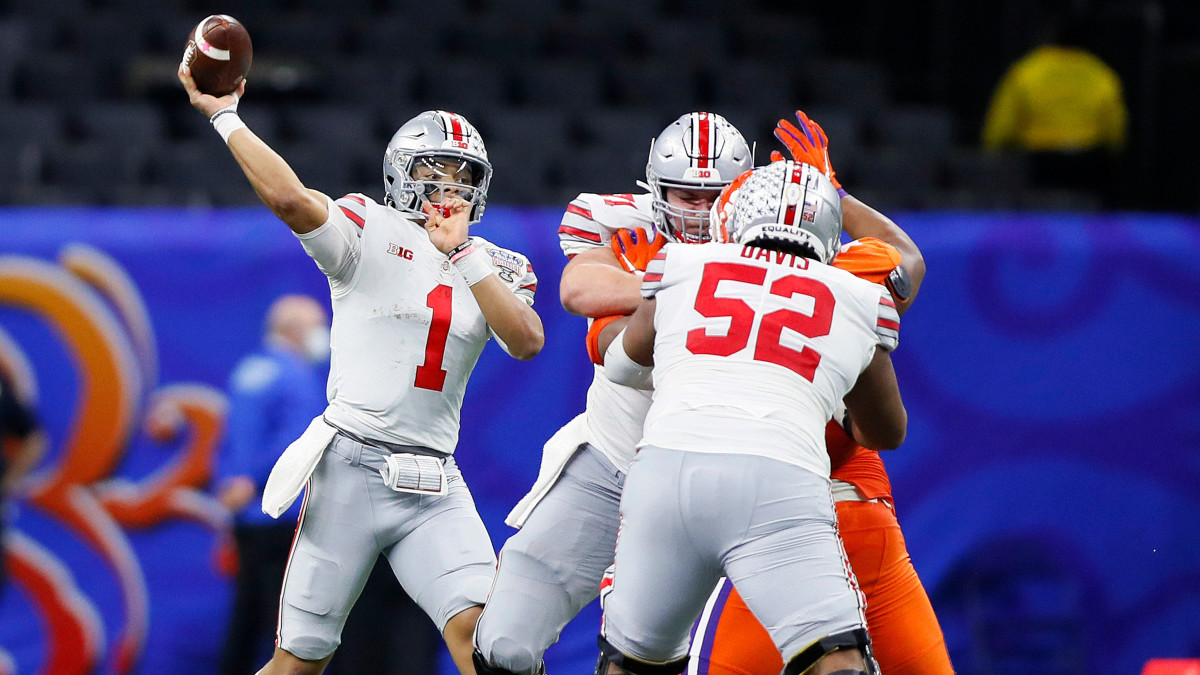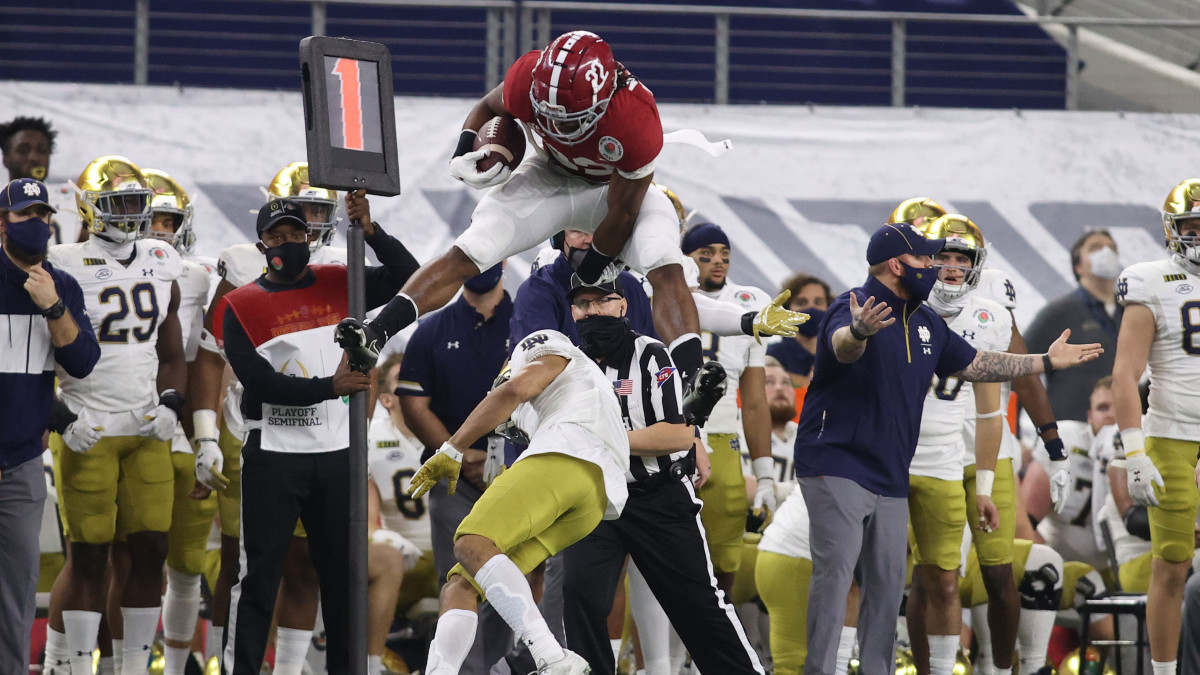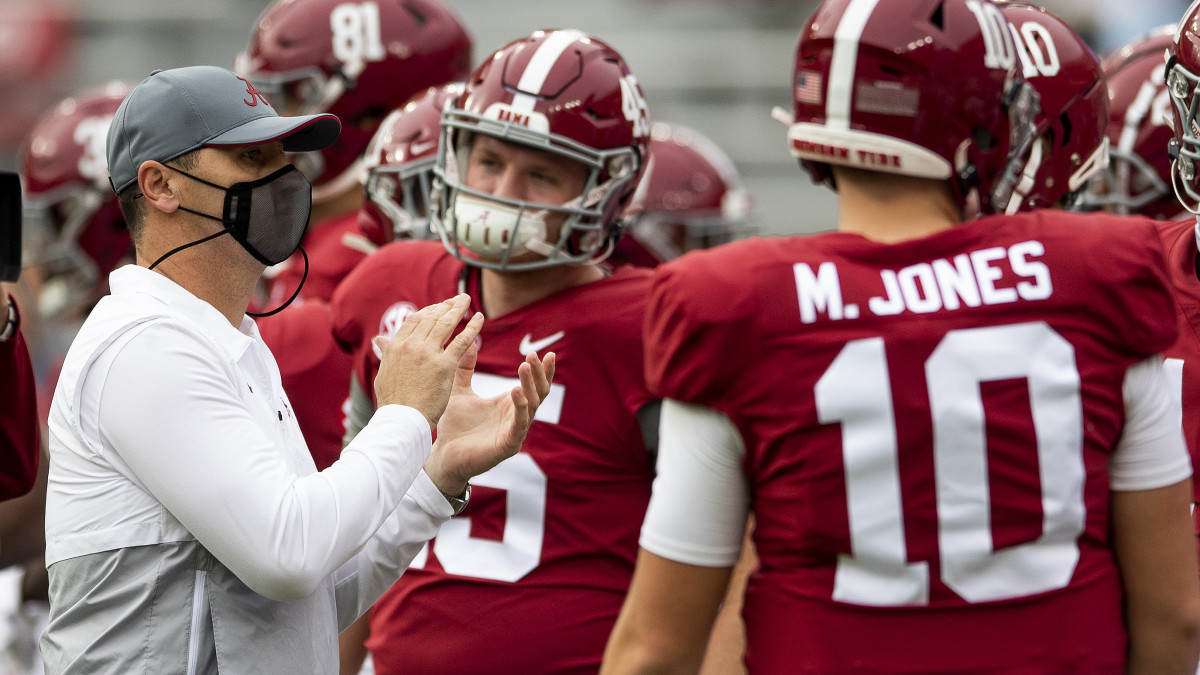As Alabama, Ohio State Prepare for National Title Game, 2014 Similarities Abound
Six years ago, a talented but inconsistent and injured Ohio State team suddenly put everything together in a smashing rout. Then in its next game, the Buckeyes upset Alabama on the way to the national championship.
Will history repeat?
The current Buckeyes are one step further along the path to a title this time around. And, of course, neither the head coach nor any of the players involved then are involved now. But there are some similarities between Ohio State 2014 and Ohio State 2020, and don’t be surprised if some of the staffers who have been part of both—defensive coordinator Kerry Coombs, defensive line coach Larry Johnson Sr., strength coach Mickey Marotti—point them out to the current Buckeyes.
The 2014–15 team had played well but not spectacularly until morphing into a monster in the Big Ten Championship Game, destroying Wisconsin 59-0 and locking up a (controversial) College Football Playoff bid. Established as a significant underdog against the No. 1 seed Alabama, the Buckeyes gouged a vulnerable defense for 42 points to pull the upset in New Orleans—highlighted by Ezekiel Elliott’s famed run “85 yards through the heart of the South” for the clinching score.

The 2020–21 Bucks had been similarly unspectacular until blowing up on Clemson Friday in the CFP semifinals, putting everything together in a 49–28 domination of the favored Tigers. And now here comes ‘Bama, favored by a touchdown in the national championship game next Monday.
It should be pointed out that this Alabama team has been significantly better than the 2014 Alabama team. But let there be no doubt that the challenge Ohio State presents is formidable. This is a juicy matchup, from the traditional stature of the programs to the firepower and pro talent both teams possess.
These are the Nos. 2 and 3 programs all-time in victories (Ohio State second, Alabama third). They both claim a bazillion national titles (some more legitimate than others). In the last decade, they are 1–2 nationally in fewest losses: Alabama with 12, Ohio State with 17—and seven of the Buckeyes’ defeats came in 2011 with an interim coach. Nick Saban has compiled a résumé that could be the greatest of all-time, but with a 23–1 record, Ryan Day has the best winning percentage of any active coach at .958.
And Day’s team is bearing a resemblance to Urban Meyer’s 2014 bunch.
Is Trey Sermon on a roll like Elliott was six years ago? Elliott finished that season with three straight 200-yard rushing games, piling up 696 yards and eight touchdowns. Sermon’s past two games: 524 rushing yards, 65 receiving, and three touchdowns. He’s run with speed, power, elusiveness—and most of all, determination. The Buckeyes do have another guy capable of going 85 yards through the heart of the South again.
Alabama counters with its own beast of a back in Najee Harris—leading the nation in touchdowns with 27 and checking in at 10th nationally in yards per game from scrimmage at 144.4. He is a reliable every-down back but also capable of the spectacular, as Notre Dame cornerback Nick McCloud learned when Harris hurdled him on a 58-yard run in the Rose Bowl last Friday.

“Harris is multidimensional, physical at the point of attack, soft hands, runs great routes, makes you work to get him down on the ground as well as any back we’ve seen,” said Notre Dame coach Brian Kelly.
One thing that seems unlikely for Ohio State is another Cardale Jones-like emergence of a backup quarterback, in case star QB Justin Fields’s rib injury against Clemson is worse than expected or he gets reinjured against Alabama. Fields took a wicked shot from the Tigers’ James Skalski and played through it, but the rest of the weekend probably didn’t feel too good. Freshman C.J. Stroud, who came in and handed off for one play while Fields regrouped, has yet to throw a collegiate pass. Even as a third-stringer in 2014, Jones had thrown 16 career passes when called upon after J.T. Barrett broke his leg.
Fields turned in one of the great performances in Ohio State history against Clemson, playing through pain and throwing for career highs of six touchdown passes and 385 yards. If he performs like that again, hooking up with elite wideouts Chris Olave and Garrett Wilson, an Alabama defense that has given up 11 pass plays of 40 or more yards will be challenged. The Crimson Tide has perhaps the premier cover corner in the nation in Patrick Surtain—“as good a corner as I’ve seen in college football, in any year,” in the words of Notre Dame offensive coordinator Tommy Rees—but Saban’s safeties are pedestrian by his standards.
Of course, on the flip side, you have an Alabama offense that has been more consistently explosive than Ohio State’s going against a defense that can be exploited. The Buckeyes are not in the national top 30 in scoring defense, top 40 in total defense or top 55 in pass efficiency defense. Indiana’s Michael Penix threw for 491 yards and five touchdowns against Ohio State, and Alabama quarterback Mac Jones is better than Penix. And his top receiver, DeVonta Smith, is simply the best in the college game.
Jones also is statistically less likely to make mistakes throwing the ball than Fields. Just 1.1% of Jones’ passes this season have been intercepted, compared to 3.1 for Fields. Jones also hasn’t had a single multi-interception game this year, while Fields threw three against Indiana and two against Northwestern.
“These guys make me look better than I am,” Jones said after the Notre Dame game, but one his best attributes is avoiding making himself look bad.

One X-factor for the Alabama offense will be coordinator Steve Sarkisian moving into dual-job mode, having been named the head coach at Texas Saturday but staying on with the Tide through this game. Some coaches under Saban have handled that well (most notably Kirby Smart, who helped Alabama to the 2015 national title before leaving for Georgia). Some have not (Saban famously fired Florida Atlantic-bound Lane Kiffin after the 2016 playoff semifinal). The expectation is that Sark will stay dialed in, especially given what Saban has done in terms of recycling his career, but that doesn’t make it easy.
Clark Lea just tried wearing two hats for Notre Dame and Vanderbilt, and the result wasn’t great: two losses and his defense gave up an average of 32.5 points in the two games. Several others have done it over the years, and most will tell you it’s really difficult. Case in point: Mark Richt, who was offensive coordinator at Florida State for the 2000 national championship game before leaving to be head coach at Georgia.
“I bit off more than I could chew, to be honest with you,” Richt said last month. “It was not a very good experience. As I was going through it, I felt like I was doing as good of a job as I could possibly do. I didn't feel like I was cheating Florida State. But in the end, the end result was we didn't score an offensive point that day. … It’s very, very difficult to do. Every time that Georgia phone rang it was some kind of issue I was trying to figure out how to solve, while still trying to be a coach at Florida State.”
Then again, one prominent example of making it work: Tom Herman. Before he became the head coach at Houston in 2015, he was the offensive coordinator at Ohio State … in 2014. He was the guy calling plays when the Buckeyes blew up at the end of the season and rolled to the national title, including that upset of Alabama.
One other X-factor, this one that could benefit the Tide. The reactions by the winning teams last Friday was a study in contrast. Alabama was businesslike as usual; Ohio State demonstrably overjoyed. Saban was matter of fact; Day’s voice full of emotion. The Tide went through the postgame victory protocol almost by rote; Coombs was doing confetti angels on the floor of the Superdome.
That may not carry over in the slightest—the teams do have 10 days between games, which allows time to recharge emotionally. But this looked a little like a Final Four where one team comes out of the semifinals already locked in on Monday and the other team comes out floating on a pink cloud of euphoria. (Think 2015, after Wisconsin beat Kentucky and Duke beat Michigan State. The Badgers didn’t have enough left in the tank to go the full 40 against the Blue Devils.)
Alabama players can act like they’ve been there before because many of them were, in 2017 and 2018. For Ohio State’s players, this is the first appearance in a national championship game.
They can, at least, call upon the institutional memory of that 2014 run. There are some resemblances between then and now.
